#construction dump trucks California
Explore tagged Tumblr posts
Text
Top Trailer Company in Bakersfield for Shipping and Logistics Needs
When it comes to finding a reliable Trailer Company in Bakersfield, Roadies Inc. is your trusted partner for all hauling, transport, and logistics needs. From flatbed to utility trailers, our company offers a wide range of trailers designed to handle any load or project, making us a favorite among shipping companies, logistics firms, and independent contractors across California. In this blog, we’ll explore how Roadies Inc. stands out as the top trailer company in Bakersfield, CA, and why our services are essential for shipping companies in Bakersfield, CA, logistics providers, and top trucking companies in Bakersfield, CA.

The Importance of Choosing a Quality Trailer Company
In the world of transportation and logistics, the choice of trailer can make or break your operations. Whether you’re moving heavy equipment, construction materials, or consumer goods, having a reliable trailer ensures the safety and efficiency of your haul. At Roadies Inc., we understand the unique demands of businesses in Bakersfield and beyond, offering high-quality trailers that meet a variety of industry needs. Our durable trailers are perfect for:
Shipping companies needing dependable trailers for transporting goods across the state.
Top trucking companies in Bakersfield, CA, who require sturdy, long-lasting trailers for heavy-duty operations.
Logistics companies that need versatile and customizable trailers to accommodate different types of cargo.
Roadies Inc: The Best Trailer Company in Bakersfield
Roadies Inc. prides itself on being a leading trailer company in Bakersfield, offering more than just trailers. We provide solutions that make hauling and transportation easier, safer, and more efficient. Our selection of trailers is crafted with the highest quality materials, ensuring durability and longevity for every customer.
Trailer Options at Roadies Inc.
Our variety of trailers includes:
Flatbed Trailers Ideal for transporting oversized and irregularly shaped loads, flatbed trailers are essential for industries like construction, agriculture, and shipping. These trailers provide flexibility and ease when loading and unloading heavy equipment or large materials.
Utility Trailers For smaller loads, our utility trailers offer a lightweight and versatile option. Perfect for personal use, landscaping businesses, and small contractors, these trailers are easy to maneuver while still providing the strength and durability required for day-to-day use.
Enclosed Trailers Enclosed trailers are designed to protect cargo from the elements, ensuring that goods are safely transported without exposure to weather conditions. These trailers are popular among shipping and Logistics Companies in Bakersfield CA who need to transport sensitive materials or valuable products.
Dump Trailers Dump trailers are perfect for industries that need to move and offload loose materials such as sand, gravel, or debris. Construction companies and landscaping businesses benefit greatly from our reliable dump trailers, making operations more efficient.
Why Choose Roadies Inc. Over Other Trailer Companies?
There are many reasons why shipping companies in bakersfield, ca and Top Trucking Companies in Bakersfield, CA choose Roadies Inc. over competitors. Here’s what sets us apart:
1. Superior Customer Service
At Roadies Inc., we prioritize customer satisfaction. From the moment you walk through our doors or visit our website, our experienced team is ready to assist you in finding the perfect trailer for your specific needs. We take the time to understand your business, offering personalized recommendations that ensure you get the best product for your hauling requirements.
2. High-Quality Trailers
Our trailers are built to last. We partner with reputable manufacturers that use the best materials, so you can trust that your trailer will withstand the test of time. This commitment to quality makes us a top choice for logistics companies in Bakersfield, CA, who rely on long-lasting equipment for their operations.
3. Affordable Pricing
We believe in offering premium trailers at competitive prices. Whether you're a small contractor or a large Shipping Company in Bakersfield CA, we have options that fit your budget without sacrificing quality. Our transparent pricing ensures there are no surprises, and we often run promotions to give our customers the best deals.
4. Customization Options
For businesses with specific needs, we offer trailer customization services. Whether you need specific dimensions, added features, or specialized designs, we can modify your trailer to suit your requirements. This makes us a valuable partner for Logistics Companies in Bakersfield CA, who often need tailored solutions for transporting various types of cargo.
5. After-Sales Support and Maintenance
At Roadies Inc., we don’t just sell trailers—we also provide ongoing support and maintenance services. If you experience any issues with your trailer, our team of experts is here to help. We offer repair services and maintenance checks to keep your trailer in top shape, ensuring your operations continue without interruption.
Serving the Heart of California's Transport Industry
Bakersfield is a central hub for transportation and logistics, connecting California’s agricultural and industrial sectors to national and global markets. Whether you're part of the oil, agriculture, or manufacturing industry, efficient transport is key to your success. Roadies Inc. is proud to be a part of this vibrant network, offering the best trailer company in Bakersfield services to support the region’s growth.
Our trailers are trusted by top trucking companies in Bakersfield, CA and shipping companies in Bakersfield, CA, helping them meet deadlines, move goods safely, and optimize their operations. When you choose Roadies Inc., you’re choosing a reliable partner in transportation.
Conclusion
When it comes to selecting a trailer company in Bakersfield, Roadies Inc. is the clear choice. Our wide selection of trailers, commitment to customer service, and ongoing support make us the go-to for shipping companies, top trucking companies, and logistics companies in Bakersfield, CA. No matter your transportation needs, we have the perfect trailer for you. Visit us online or in-store today and let us help you find the trailer that fits your business perfectly.
0 notes
Text
How to Get the Most Out of a 40 Yard Dumpster Rental Service in California

Among the multiple matters and responsibilities that the complicated construction projects, the renovations that are done at a large scale or the thorough cleanout procedures are dealing with the waste problem in an optimal manner becomes a top priority. In California, the best solution to handle tons of debris is undoubtedly a 40 Yard Dumpster Rental Service in CA. In-depth insights, applications, and factors related to the 40-yard dumpster rental service to help you with the project will be covered in this guide, making sure you obtain enough knowledge to build a successful project.
What is a 40-Yard Dumpster?
A 40-yard dumpster is a sizeable container available for rent capable of holding a great deal of waste. The measure is approximately 22 feet long and 8 feet wide and 8 feet high. It is one of the dumpsters that can accommodate various debris types including the difficult ones, thus it is an ideal solution for tasks that required the use of large areas.
Key Benefits of a 40-Yard Dumpster Rental
High Capacity: At 40 cubic yards, this dumpster can lift volumes of waste very high, so the need for smaller containers decreases drastically.
Versatility: Capable of dealing with a variety of construction work such as the construction of large structures, serious renovation or even a complete house cleanup, this dumpster is suitable for all kinds of projects.
Efficiency: By laying out a central dump for the debris, the dumpster shortens the debris collection and transportation to the dumpsite. This guarantees a site that is not only cleaner but safer too.
Cost-Effective: The cost of renting one big dumpster is more beneficial than the cost of renting several. This will include the rental fee of the dumpsters as well as the disposal fee of them.
Ideal Projects for a 40 Yard Dumpster
Construction and Demolition: It is best to use this size when the construction and demolition sites create large amounts of concrete, wood, metal and other materials.
Major Home Renovations: The use of the container can allow you more working space for your renovation works and addition of such house systems as new roofs, extra siding, cooling or heating systems, and others. Without a doubt, home renovation involves whole house remodeling which is a project that can be expensive.
Commercial Cleanouts: The relocations, downgrades, and the large cleanouts are enabled by this dumpster. They are good for small to mid-sized businesses that are either addressing a remodel or are downsizing and have to discard office furniture and equipment in bulk.
Disaster Cleanup: It may be utilized after ecological catastrophes such as inundations, fires, or storms; there is a need for extensive removal of destroyed materials.
Factors to Consider When Renting a 40 Yard Dumpster
Space Availability: A large flat surface is needed for the dumpster to be placed. The site should be clear of any trees, poles, or other obstructions as well to accommodate the movement of an end sheet delivery truck. Additionally, if your driveway is in good condition a dumpster might be delivered to it and picked up from there. In case of inevitable movement caused by a big tree, consider having branches pruned. This is quite obvious as a proper placement of the dumpster can be achieved by making a proper estimate of the lane width and height required to deliver and pick material with the attachments showing under the materials. It requires a large, flat area for placement and easy access for delivery and pickup.
Type of Debris: To clarify your expectations for the rental project, customers should identify the type of debris they will dispose of. For those items which are regarded as a safety hazard, they probably will not be accepted.
Rental Duration: Be your own judge as you decide how long you are going to have the dumpster rented out. It is essential to have a rapid solution to your waste problem, and still, waste payment is not a problem with some companies while the other require longer rentals thus this affects the total bill.
Local Regulations: Understand the municipal legalities when it comes to the dumpster and the waste. Certain areas will be requiring a permit in case you wish to place a large container on the street, or there is a specific way the cart is meant to position the cans.
Cost of Renting a 40 Yard Dumpster in California
The price of a 40-yard dumpster rental in California relies on numerous aspects such as the site, the number of days one rents, and the type of debris. Roughly, the mean price you are going to pay spans from around $500 to $1000 on a month. Get inquiries from several providers' organizations to guarantee that you have gotten the most perfect offer for the work you want to complete.
Finding a Reliable Dumpster Rental Service
When choosing a dumpster rental service in California, consider the following tips:
Reputation: Look for companies with positive reviews and a strong reputation for customer service and reliability.
Transparency: Choose a provider that offers clear pricing, including any potential additional fees.
Flexibility: Make sure the rental service can meet your schedule and specific project needs.
Support: Choose a company that offers great customer support to help you deal with any issues you may encounter during your rental period.
Conclusion
Get a 40 yard dumpster rental in CA is a practical and efficient solution for managing large amounts of waste. By understanding the benefits, uses, and considerations for this high-capacity container, you can ensure your project runs smoothly and stays on schedule. Whether you’re doing a large construction job, extensive renovation, or an important cleanup, renting a 40-yard dumpster gives you the capacity and convenience you need to handle your waste with ease.
0 notes
Text
Dump Truck Driver Jobs in Zucchi Trucking in CA USA 2024
Dump Truck Driver Jobs in Zucchi Trucking in CA USA 2024 Zucchi Trucking was established in 2017 in California USA this company provides mostly hauling truck transport services to construction companies, Zucchi trucking provides transport services to construction industry today this company is looking for an experienced Dump Truck Driver who is eligible to work in California USA; Dump Truck…

View On WordPress
0 notes
Text
...
In recent decades the Inland Empire — comprised of San Bernardino and Riverside counties — has been the primary victim of America’s warehouse boom. As demand for online shopping has surged — e-commerce sales grew 50% to $870 billion during the pandemic alone — this region has served as a billionaire’s dumping ground. Those are the words of Tom Dolan, executive director of Inland Congregations United for Change. “Now it’s no longer just Warren Buffet, it’s Jeff Bezos and Amazon,” Dolan told The Guardian in 2021. “And we’re paying the cost of doing their business.”
That business is only made possible by taking out a nonconsensual loan from the residents of surrounding communities. It’s a coercive trade: the health and safety of citizens for the profits they’ll never share. And no worthwhile efforts have been made to pay off that debt.
In order to fulfill the glamorous promises of expedited, overnight and same-day deliveries, diesel trucks conduct over 600,000 daily trips through the Inland Empire alone, carrying roughly 40% of the nation’s goods. These vehicles emit 1,000 pounds of diesel particulate matter every day (alongside 100,000 pounds of nitric oxide and 50,000,000 pounds of carbon dioxide).
The International Agency for Research on Cancer has classified diesel particulate matter as a Group 1 carcinogen — the most severe category — due to sufficient evidence linking diesel exposure to lung cancer. (Other studies have suggested a relationship to cancers of the bladder, larynx, esophagus, stomach, pancreas and blood, alongside asthma, other respiratory disease, heart attacks and premature mortality.) The region bordering the warehouse hub in one Inland Empire city, Ontario, ranks in the 95th percentile of cancer. A 2015 study estimated that 70% of the total cancer risk from air pollution in California is caused by diesel exhaust alone.
An Undue Burden
The people who suffer the consequences of our online shopping are not typically over-consumers themselves. The South Coast Air Quality Management District found that the 2.4 million people living within half a mile of a warehouse are also disproportionately Black and Latino communities below the poverty line. In 2012 San Bernardino ranked as the second poorest city in America with over 34.6% of people living in poverty. And of all the residents living within a mile of the average Amazon warehouse, 80% are people of color.
In January a coalition of over 60 environmental groups (including the Center for Biological Diversity, publisher of The Revelator) wrote to Gov. Gavin Newsom and asked him to declare a public health state of emergency in the Inland Empire. The request included testimony from residents on their firsthand experiences dealing with the everyday reality of increased asthma attacks, nose bleeds, hospitalizations, and coronary episodes. Given “nowhere else to turn,” they’re demanding government intervention, alongside a moratorium on new warehouse construction until the health consequences can be better understood.
0 notes
Text

Transit Talk Thursday time: From one side of the country to the other side, this week it's all about the Pacific Surfliner in California dreamin-sorry, force of habit.
Point of interest this time around is how it irritates me how transit projects will never get the love and care they deserve and instead we dump billions into roads because America is the land of the car and those who take transit are poor people and other scum of the Earth.
So for the uninitiated, the Pacific Surfliner is an intercity Amtrak route that runs along the west coast of California between San Luis Obispo to San Diego. As the name implies and as the picture shows, the route runs directly on the coast, hence the name "Pacific Surfliner". And unfortunately, loose ground and a rail ROW are not a friendly combination. The Pacific Surfliner's been in the news quite a bit because the ocean really wants to get up and personal with the rails, which runs the risk of the track becoming unstable, so either the line has to run reduced speeds or the entire line has to be closed down. And when it gets closed down it stays that way for quite a while, which sucks as it's the busiest service Amtrak runs beyond the Northeast Corridor, so a LOT of people depend on this thing.
"Oh well y'know a lot of stuff gets closed down, it was back and running before you even knew it" Oh I wish lol, when coastal erosion was found in San Clemente, the Surfliner got closed on September 30th, 2022 to have emergency work done on it. Estimated downtime was about 3 months. It took 7 for it to fully reopen. Yeah I shit you not it took all the way until April of this year for the Surfliner to resume full operations, and even then California had to close it AGAIN literally ten days later. And then after THAT it had to close down AGAIN for nearly TWO MORE MONTHS.
And if you don't believe me, here's some stuff talking about it
Are you starting to see where my anger is coming from?
We consistently continue to do these fucking Band-Aid brand fixes to our transit infrastructure instead of actually treating it with the love and care that it deserves. Meanwhile in road land, as soon as something catastrophic happens we call in the motherfucking Avengers of emergency infrastructure repair who will work nonstop to get everything back the way it was before faster than Usain Bolt can do a lap on the track. Don't believe me? Look at when a bridge on i95 in Pennsylvania collapsed due to a truck catching fire underneath it. Construction crews worked 24/7 round the clock to get it repaired in two weeks.
This kind of emergency repair is super possible, it's just political willpower just isn't there to get it done. Oh and as a side note, another issue with the Surfliner getting any major renovations done is because the Surfliner's an absolute mess in terms of who owns the right-of-way.

I wasn't able to find a map that showed ownership of the Surfliner so bear with me here About a third of the Surfliner ROW is owned by BNSF and Union Pacific, BNSF owning the route from Los Angeles to Fullerton, and Union Pacific owning from San Luis Obispo to Moorpark. Moorpark to LA and Fullerton to the Orange/San Diego County Line is owned by Metrolink, the route from the county line to San Diego is owned by the North County Transit District. So that's 4 different companies owning bits and sections of one rail ROW. That's gonna make it quite difficult to get any real work done here, especially since freight companies are near-impossible to work with. Oh, but it gets so much fucking better. In addition to the ownership nightmare, to try to "coordinate" infrastructure improvements, the Los Angeles-San Diego-San Luis Obispo Corridor Agency, or LOSSAN, assumed oversight in 2015. This is a 13 member organization composed of:: -Southern California Association of Governments (SCAG) -Ventura County Transportation Commission (VCTC) -Riverside County Transportation Commission (RCTC) -North County Transit District -Amtrak -California High Speed Rail Authority -San Diego Metropolitan Transit System (MTS) -LA Metro -California Department of Transportation (Caltrans) -Orange County Transportation Authority (OCTA) -San Luis Obispo Council of Governments (SLOCOG) -San Diego Association of Governments (SANDAG) -Santa Barbara Association of Governments (SBCAG) That's one clusterfuck of an organization, with each member being responsible for different parts of the Surfliner corridor, so you won't have a "one to rule them all" in terms of progress on infrastructure projects. There is hope coming, as there has been talk about adding a tunnel in San Clemente to move the ROW inland to prevent further coastal erosion threatening the tracks.

As of now work hasn't begun just yet, so here's to hoping this project gets the green light and work begins soon, but knowing this country, that's gonna take a while. Wow that was quite a detour, so I guess to close out it's pretty much the same thing as the whole "Wah we don't have the money to spend on this transit project!" when it's clear we very much do since we spend so much more on highways, but when it comes to infrastructure improvements like these we can get them done quickly and effectively. We just need to actually get the willpower to do it. It's really not that hard.
0 notes
Text
Monday, September 11, 2023 Canadian TV Listings (Times Eastern)
WHERE CAN I FIND THOSE PREMIERES?: HALLOWEEN BAKING CHAMPIONSHIP (Food Network Canada) 9:00pm
MLB BASEBALL (SN) 1:00pm: Atlanta vs. Phillies (SN) 7:00pm: Rangers vs. Jays (SN1) 7:00pm: Yankees vs. Red Sox (SN Now) 9:30pm: Angels vs. Mariners (SN1/SN Now) 10:00pm: Padres vs. Dodgers
FAMILY FEUD CANADA (CBC) 7:30pm (SEASON PREMIERE): Chiiiiick-eeeennnn!
SHERLOCK (CBC) 8:00pm (SEASON PREMIERE): Sherlock Holmes returns to Britain as Watson and his wife prepare for their first child.
DEPARTURE (Global) 8:00pm: Kendra and her team go rogue and discover the true cause of the ferry's sinking.
STAYING INN: HOTEL JULIE (CTV Life) 8:00pm: The team want to show off their creativity, but a unique doorway, a bold fabric, and construction snafus leave the team in gridlock.
NFL FOOTBALL (TSN/TSN3/TSN4/TSN5) 8:15pm: Bills vs. Jets
COUNTRY HOUSE HUNTERS: CANADA (CTV Life) 8:30pm: Heather and her mom, Diane are looking for the perfect family home.
BASED ON A TRUE STORY (W Network) 9:00pm: A realtor and a former tennis star struggle to stay afloat in life and love as a serial killer puts Los Angeles on high alert.
MASTERCHEF UK (CTV Life) 9:00pm (SEASON 18 PREMIERE): Amateur cooks compete for a place in the competition and the right to wear a coveted apron.
TURN UP THE VOLUME (YTV) 9:00pm: The Volume reel from their rejection, and Vivi tries to figure out who she is – but making herself more Asian doesn’t come easily.
GHOST HUNTERS (DTour) 9:00pm (SEASON PREMIERE): The Walking Dead's Chandler Riggs and TAPS meet up in California to investigate a former Wild West jail; Satori Hawes and Cody DesBiens join the team as they confront the ghostly inmates trapped inside this imposing old building with a horrific past.
HIGHWAY THRU HELL (Discovery Canada) 10:00pm: MSA and Reliable team up for a wreck on the Canyon Highway's notorious Killer's Corner; Jamie uses a rollover as an opportunity to teach crew new skills; Team Quiring meet the challenge of a swamped-in dump truck with a bulldozer.
#cdntv#cancon#canadian tv#canadian tv listings#family feud canada#departure#staying inn: hotel julie#country house hunters: canada#turn up the volume#highway thru hell#mlb baseball#nfl football
0 notes
Text
BEHIND THE WHEEL!
Lucy & Cars ~ Part Two

In the 1960s America took to the open road. Everyone owned a car - and Lucy Carmichael was no exception. In Danfield and Los Angeles “The Lucy Show” was motorized!
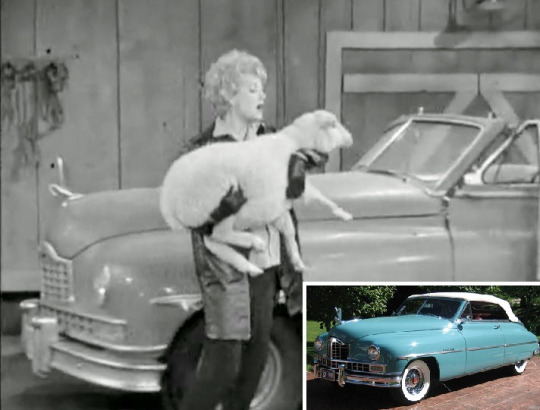
“Lucy Buys a Sheep” (1962) ~ When Lucy goes to pick out a sheep to act as a lawn mower, she drives a 1949 Packard Super Deluxe 8 convertible. Packard started making automobiles in 1899 and went out of business in 1958, four years before the series premiered. Future episodes indicate that Lucy doesn’t own a car, so the Packard may belong to Viv.

“Lucy and Viv Are Volunteer Firemen” (1963) ~ As the Chief, Lucy gets to drive the fire truck! This is a Moreland Truck, a company based in Los Angeles.
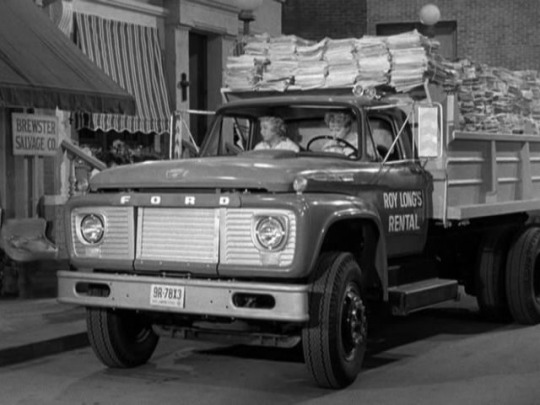
“Lucy Drives a Dump Truck” (1963) ~ The title tells it! Lucy and Viv drive a 1956 Ford F-Series dump truck to deliver recycled newspapers for cash. The truck has 'Roy Long's Rental' written on the doors. In reality, Roy Long was Desilu's construction superintendent. This is a huge production for the series, using more than a dozen extras, 160,000 newspapers, an enormous sound stage dressed as a city street, and six vehicles.

Parked on the street is a 1961 Chevrolet Apache light-duty truck with a Fleetside bed option. [More about motorcyles in a future blog.]
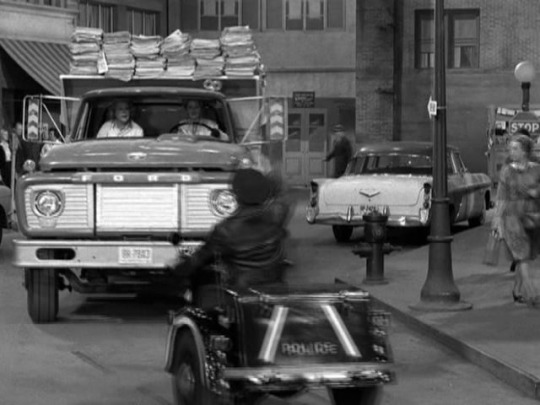
The dump truck passes a 1956 De Soto Fireflite Four-Door Sedan.
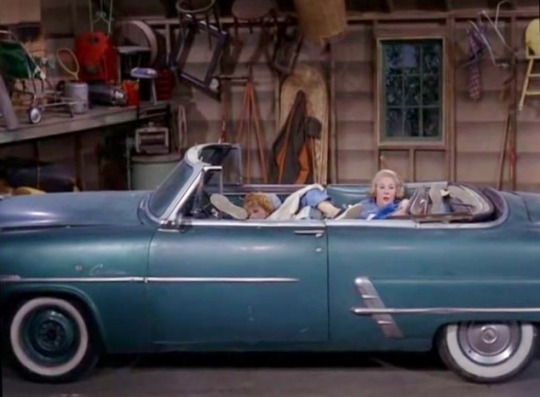
“Lucy Decides to Redecorate” (1963) ~ When they redecorate the house, Lucy and Viv must sleep in the car! Viv's car is a 1953 Ford Crestline Sunliner convertible. This is the first time we have seen inside the Carmichael's garage.
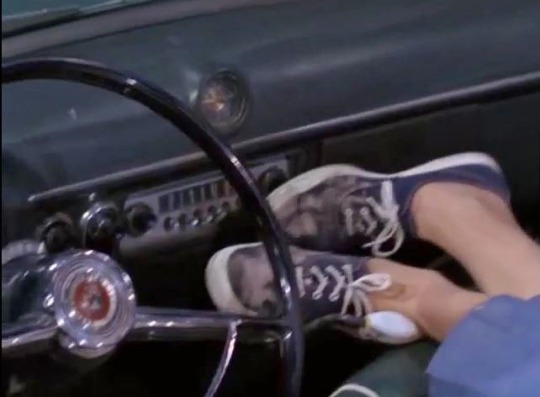
A close-up of the interior of the vehicle and Lucy’s feet!

In her sleep, Lucy’s foot hits the gear shift and the car crashes through the living room wall.
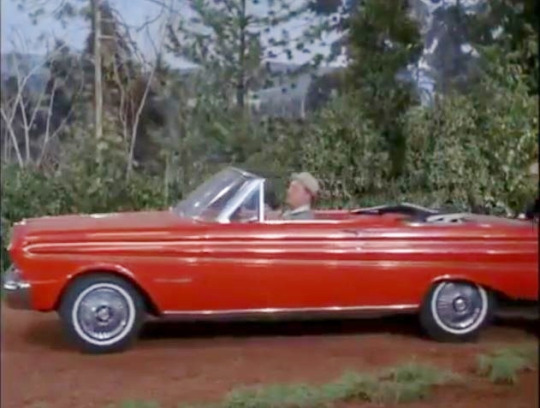
“Lucy, the Camp Cook” (1964) ~ Mr. Mooney drives to the camp in a 1964 Ford Falcon Sprint. The Sprint was overshadowed by the Mustang and was discontinued after 1965. When the car runs out of gas, they must hitchhike.
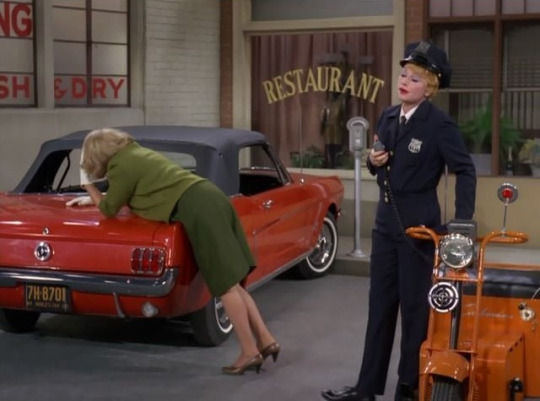
“Lucy the Meter Maid” (1964) ~ Is another exterior street set featuring lots of vehicles. A 1965 Ford Mustang may also be the same car used in an October 1964 episode of “The Dick Van Dyke Show,” also filmed on the Desilu lot.
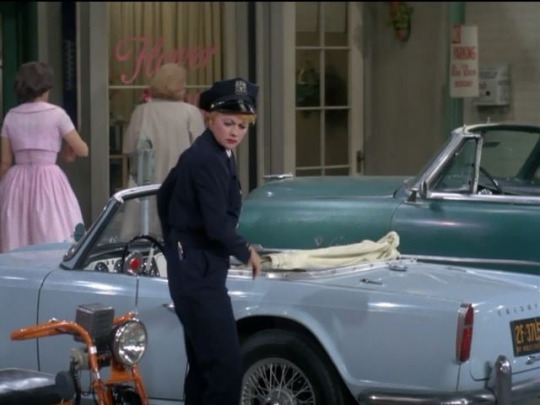
Lucy tickets a 1962 Triumph TR4. In court, the Judge admits to owning a “1964 blue convertible” which may be a reference to this car, despite the difference in the actual model year. The license plate is a 1964 NY World’s Fair commemorative plate. Behind it is the 1953 Ford Crestline Sunliner previously seen in “Lucy Decides to Redecorate”.

“Lucy Makes a Pinch” (1965) ~ On a stake-out, Lucy and Detective Baker park on Lover’s Lane in a 1964 Lincoln Continental convertible.
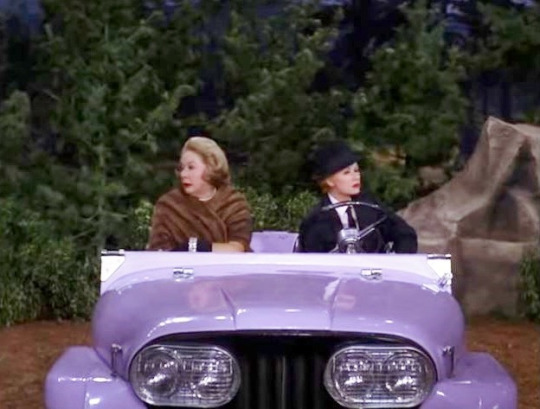
When Lucy and Viv are on their own stake out, they are sitting in a customized Jeep CJ-5. It is never stated where or how they acquired a lavender jeep!

“Lucy at Marineland” (1965) ~ When the show relocates to California, the first episode opens with location footage of Marineland in Rancho Palos Verdes, California . Mr. Mooney agrees to leave work at the bank and drive Lucy and Jerry to Marineland in his light colored Ford Falcon convertible.
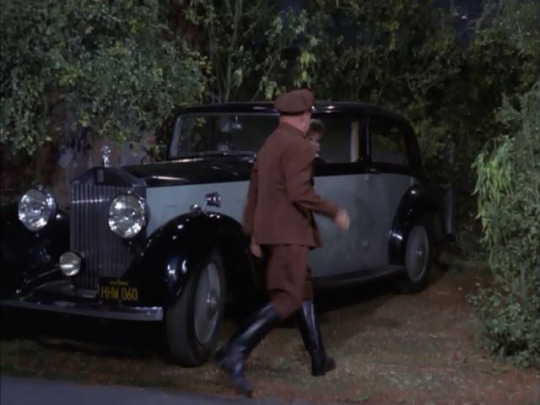
“Lucy and the Undercover Agent” (1965) ~ Lucy, Mr. Mooney, and the Countess go undercover. Mr. Mooney is the chauffeur of a Rolls-Royce 25/30 HP Park Ward swept-tail saloon car.

In 1965, Lucille Ball and her husband Gary Morton filmed a home movie while vacationing in Monte Carlo. The film takes place on the streets and features many vehicles.
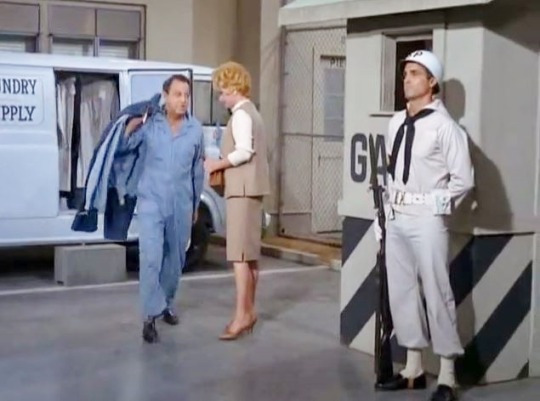
“Lucy and the Submarine” (1966) ~ Before sneaking onto the submarine, Lucy hides out in a parked Laundry van.

“Lucy and the Ring-A-Ding Ring” (1966) ~ In this episode Mr. Mooney drives a red Volkswagen convertible bug, a somewhat unusual choice for a middle-aged banker during in the mid-1960s.
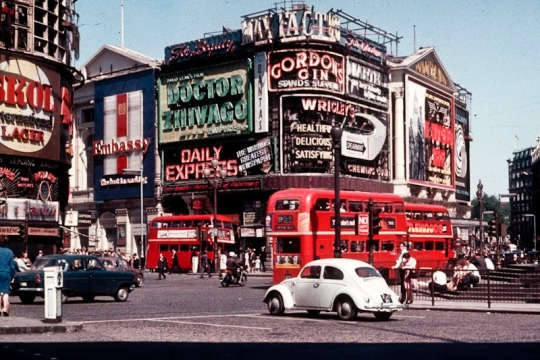
“Lucy in London” (1966) ~ The special was shot on location. Footage of Picadilly circus includes many vehicles, including a white VW Beetle.

“Lucy Puts Main Street on the Map” (1966) ~ A news crew operates out of a blue hatchback station wagon. The camera is mounted on the roof.

“Lucy Gets Involved” (1968) ~ Lucy moonlights as a carhop at a drive-in burger joint. The episode features the light blue 1962 Triumph TR4 convertible previously seen in “Lucy, the Meter Maid”.

The scenes feature a blue Ford Convertible, a vintage 1920s Roadster, a blue Sports Car, a red VW Beetle with Moon Roof, and a Police Car.
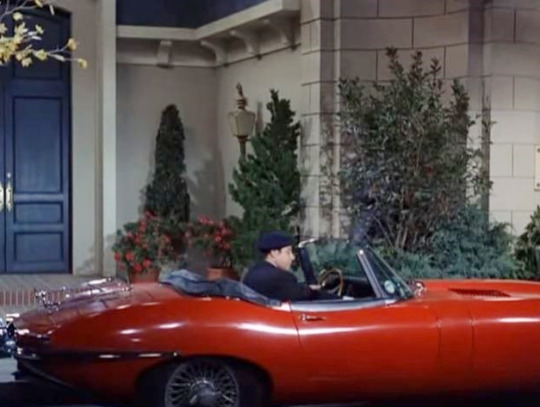
“Lucy and the Stolen Stole” (1968) ~ Buddy Hackett plays a conman who drives a little red sportscar.
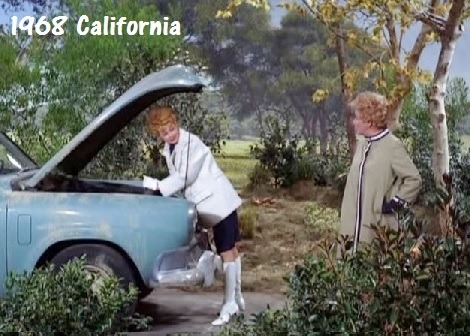
“Lucy and the Lost Star” (1968) ~ Before arriving at Joan Crawford’s mansion, Lucy and Viv’s car breaks down in the middle of nowhere.
#The Lucy Show#Lucille Ball#Gale Gordon#Vivian Vance#cars#trucks#automobiles#tv#Lucy#Desilu#vehicles#car
0 notes
Text
Are you searching for a Reliable and Affordable Dump Truck Service?
Dump truck rental california
There are several business in The golden state that use dump truck rentals. Some preferred options consist of United Rentals, Sunbelt Rentals, and RentalWorks. These firms generally have a variety of dump vehicle sizes offered for lease, as well as they might additionally supply extra services such as shipment and also pick-up of the rental tools. It is best to call the rental business directly to obtain even more info on the certain alternatives as well as rates readily available in your location.
End dump truck california
End dump trucks are a type of vehicle that are typically utilized in The golden state for building and construction as well as transportation of different materials such as dust, sand, crushed rock, as well as various other aggregates. These trucks have a big flexible container or trailer that can be tilted to dump its load at the end of the vehicle. They are functional and also efficient lorries that are often utilized for carrying large quantities of materials for building tasks, extracting procedures, and various other markets. Some popular brands of end dump vehicles utilized in California consist of Mack, Kenworth, Peterbilt, and Freightliner.
Super dump truck california
A super dump truck in The golden state is a large business automobile that is utilized for hauling heavy loads, such as building and construction products, dirt, as well as particles. These vehicles are generally equipped with a large dump bed that can be increased and also reduced to dump the lots. They are also outfitted with effective engines and large tires to handle the weight of the load. Super dump trucks are typically made use of in building, mining, and also demolition jobs in California.
Construction dump truck california
Construction dump vehicles in California are used to move building materials such as dirt, gravel, as well as debris to and also from construction websites. These trucks are generally huge as well as heavy-duty, with a big open bed on the back for bring materials. They are available in a variety of dimensions as well as designs, including standard dump vehicles, articulated dump trucks, and also off-road dump vehicles. They are commonly used in building jobs such as roadway building, bridge building and construction, and also land advancement. These vehicles are operated by qualified as well as certified motorists, and are subject to security policies as well as assessments.
10 wheeler dump truck California
A 10 wheeler dump vehicle in The golden state is a type of sturdy vehicle that is commonly made use of for building and also transport of products such as dust, sand, crushed rock, as well as debris. These vehicles are equipped with a big dump bed that can be raised and also decreased making use of hydraulic systems, allowing for easy loading and unloading of materials. They are commonly powered by diesel engines and also can hauling big amounts of freight. They are generally utilized in building, mining, and also landscape design industries.
For best truck services at affordable price you can visit our website https://sekhonandsontrucking.com/
0 notes
Text
Vacuum Trucks Victoria, Texas
These numbers characterize the median, which is the midpoint of the ranges from our proprietary Total Pay Estimate mannequin and based mostly on salaries collected from our customers. Additional pay might embrace money bonus, fee, tips, and profit sharing. The "Most Likely Range" represents values that exist inside the twenty fifth and 75th percentile of all pay knowledge out there for this role. Our advantages are the richest within the business – that’s we strive to take care of our high caliber workforce. We use solely high quality confirmed elements in all of our manufactured products.
Sign up for our quarterly e-newsletter for company updates and trade developments. The warning listed above is supplied to California consumers to ensure compliance with California Proposition sixty five. Largo is a DOT registered cargo tank manufacturer and Final Stage Vehicle producer ensuring compliance with all applicable laws.
Sometimes a chemical unexpectedly mixes with one other to produce a dangerous substance; for instance, when hydrochloric acid is added to the residue of different merchandise in a tank it might possibly release fumes, which may be lethal. The several types of vacuum vehicles on the market include conventional vacuum loaders and trendy combo units. The type of oilfield automobile you need is determined by your requirements, and you'll rely on Curry Supply to offer professional advice when attempting to choose on a truck to purchase. Reach out to Curry Supply at your convenience and allow us to give you an oilfield vacuum truck that is appropriate for high-intensity operations, meets your unique wants, and fits your price range. We ship our merchandise globally, serving to our customers from all parts of the us run their companies easily and increase their revenue by boosting revenues and decreasing maintenance costs.
The TURBO Series vacuum pumps are crafted with a cast iron body to ensure most reliability. Cast Iron is probably the most efficient material for releasing heat from the pump. The air intake and discharge are designed to scale back noise and heat production. The increase within the capability to deal with heat has been improved upon by the introduction of two cooling fans.
Our vacuum tanks are designed, examined, and confirmed to perform in any setting, bringing you a chance to increase your revenue, productivity, and uptime. Drillwell owns and operates a contemporary vacuum truck oilfield fleet of 130 BBL vacuum vans, end-dumps for hauling drill-cuttings, and SuperVacs. We are able to servicing drilling, completions, and manufacturing sites.
We imagine that a person’s word still counts for one thing, that a deadline is a deadline, and that high quality isn't an choice – it’s a necessity. As a result, our customers get pleasure from the benefits of smoother operations, decreased downtime, and increased effectivity. One crucial protected procedure that operators should observe is the requirement for proper disclosure, Phillips says. Sometimes, purchasers vacuum truck oilfield do not reveal the character of the hazardous waste. Other dangers stem from the want to work with sizzling water, which might leave employees burned or scalded. Vac truck operators additionally cope with extreme weather situations and, as a result of work continues around the clock, they typically work in the dark with limited lighting.
Larger capability stainless-steel holding tanks like our 4200 US GAL items (1000 water/3200 debris) imply a larger tank with greater energy constructed to resist up to 30 PSI of inside pressure and to satisfy ASME/DOT compliancy. Services corresponding to production saltwater hauling may be quoted by the hour plus disposal, or on an all inclusive basis. We are proud to be a number one oilfield service supplier in the Permian Basin.We send certified CDL Drivers who are licensed, bonded, insured, and operating inspected vehicles. Our 130 BBL Vacuum Trucks and trailers are outfitted with over-sized 4-inch vacuum pump hoses and 4-inch ball valves for a lot faster filling and emptying.
Flowback requires extremely specialized tools that meets production testing and backflow necessities. They provide advantages over other corporations that don't have both sufficient vacuum gear or the mandatory vacuum truck oilfield vacuum experience. Energy Information Administration , Natural fuel production is predicted to continue growing this year – due entirely to the enlargement of fracking applied sciences.
0 notes
Text
What Are Some Interesting Historical Facts About Construction Dump Trucks?
Dump trucks have become an inseparable part of the construction industry. With the global dump trucks market size projected to reach USD 10.83 Billion by 2026, the demand for them will continue to grow is indispensable. But you may wonder how the need for dump trucks started and its journey came to such a state where they are now so technologically advanced and continue to be so.
This article covers some interesting historical facts about construction Dump trucks which are as follows-
· The history of construction dump trucks can be traced back to The Anthony Company released a publication named ‘A Pictorial History of Vehicle Dump Bodies’, which showed a hydraulic hoist in the United States when it was used to unload grain from a farm wagon.
· The First hydraulic hoist was built in 1904 or 1905 in England on a Robertson Steam Wagon.
· Some of the earliest dump trucks do the dumping depended upon gravity—for example, Mann steam truck from England.
· A bottom dump trailer consists of a clamshell dump gate on the bottom of it. Some bottom dump trailers are mounted between two axels and are generally pulled by horses.
· Lauth- Juergens, which is today famous for Hendrickson truck, is where Magnus Hendrickson got his start. Some photos in Anthony's booklet show a circa 1910 Lauth- Juergens, which looked like a mechanically raised dump body.
· The first dump truck was manufactured in Stoughton, Wisconsin, which was around 100 years ago. This dump truck was known as the "Harvester" dump truck, and it was manufactured by Bucyrus-Erie. The dump trucks that were created after this dump truck were all large in size because they used steam to power them.

From 1911- 1920-
· In this era, Dump Trucks have become indispensable.
· At this time, motor trucks came into widespread use. For dumping purposes, motor trucks are widely preferred instead of horses or mules.
· Couple Gear Tractor was used by a firm in Brookline, which pulled a wagon carrying 3 tons of coal. It consists of dumping installation.
· Some pictures from Norton’s book show dumping trucks have multiple hoppers—generally used in coal yards where each hopper contains coal for an individual customer.
· Kilbourne and Jacobs Manufacturing Company of Columbus, Ohio, built Seven dump body style dumping trucks.
· In 1920 Ford has a hand crank and hoist on a dump body.
From 1921 – 1930
· As with the rise of the economy and industry's need for dump trucks boomed, many technological changes started taking place.
· Now dump trucks were created to haul heavy loads such as coal.
· The development in construction dump trucks includes four-wheeler hydraulic brakes, air brakes, dual powered rear axis.
In today's scenario-
· Nowadays, construction dump trucks California are backed up with high-performance engines, fuel, and, most importantly, getting bigger.
· New articulated models have much more powerful features and efficiency than before.
Hence, we see how the journey started from a hydraulic hoist to overcome too many powerful construction dump trucks and continue to do so. Sekhon and Son is a Dump truck rental and provides construction dump trucks in California. Our services include Double bottom dumps, Super dump or mega dump, and so. We have covered northern California, from Central California to Shasta, and South California from Central Coast to south Coast.
For more details:
Website - https://sekhonandsontrucking.com/ Name – Sekhon and Sons Trucking, Inc. Email - [email protected] Address - 770 Frontage Rd, Ripon, CA, 95366. Contact no - (209)4847474 Facebook: https://www.facebook.com/sekhonandsontrucking
0 notes
Text
Hi! Let's talk about neighborhood accessibility for a moment:
Every morning that I possibly can, I start the day with a 30 minute -ish walk in my neighborhood. (Tangent for another day: sure this is "exercise" but why I really commit to this practice is that it does WONDERS for my mental health and lets me "complete the stress cycle" in a way my body needs and wants. I really can't say enough how precious this time has become to me.) In the process, I have become much more intimately familiar with my neighborhood from an up close perspective that driving doesn't allow. I've grown increasing disturbed by how so many of my neighbors are repeatedly and flagrantly contributing to accessibility issues for disabled people who also live here, undoubtedly leading to challenges, frustrations, and greater isolation. While my current neighborhood is in south Austin, TX I know that there are neighborhoods just like mine all across the country...I grew up in one in Indiana. I've personally seen them in Colorado, California, New York, Illinois, and New Jersey. So I decided to raise a little awareness about this with real life examples. I don't talk about this stuff enough with folks who know me "IRL" so today my (long) Instagram story is called, “my neighborhood is hostile to disabled people and yours probably is too.” If you, like me, have been privileged with 2 legs, eyes, and other body parts that work relatively well up to this point in your life, it can be easy to assume that we all experience our neighborhoods similarly. This is DEEPLY untrue. So that's where this story picks up... (Image descriptions under the cut.)










Image 1: Shows a sidewalk ending abruptly in someone's yard. Text over the image reads, "But people who use mobility aids and depend on sidewalks to safely get out of their block are often forgotten. Here are just a few examples I peeped today:" Image 2: Shows a different side walk that abruptly ends in someone's right at a sewer access point. Text over this image reads, "Here’s a sidewalk that dumps you out in grass and no ramp. This is a HUGE gap in public accessibility in neighborhoods like mine. In fact, there are *no streets* with continuous sidewalks anywhere near me. They stop and end at random everywhere.: Image 3: Shows a sidewalk next to parking spaces where there is a big gap between the sidewalk and the asphalt, with parking bumpers in between the asphalt and the sidewalk. Text on this image reads, "Tell me, how does a wheelchair user get to the sidewalk? These parking stops are like 2 feet apart." Image 4: Shows a sidewalk with a pickup truck in someone's driveway that is parked covering 100% of the sidewalk's passage. Text on this image reads, "When there ARE sidewalks, people with huge vehicles park with their bumpers across the sidewalk. Other people become a HUGE accessibility obstacle for their neighbors. If you are bling, easily navigating around this will be a challenge. Image 5: Shows a construction pallet of materials sitting squarely in the public sidewalk. Text on the image reads, "Speaking of people blocking their neighbor’s access, let’s see how construction (gentrification, mind you) impacts things". Image 6: Shows more construction materials in someone's yard carelessly stored across 100% of the sidewalk space in front of a hour. Text over the image reads, "SERIOUSLY? The sidewalk is not yours to use as you see fit for personal storage. This stuff has been here for MONTHS at this point." Image 7: Shows another home renovation/construction site where the dirt/soil has been dug up around the sidewalk and is covering it all. No text, but a giphy of a facepalm reaction is overlaid. Image 8: Shows a badly damaged and in horrible shape sidewalk over a bridge. Text over the image reads, "This neighborhood was developed in the 60-70s and its infrastructure is crumbling like so much of our nation. We are all at danger when bridges start crumbling, but especially if you use mobility aids and the sidewalk is falling and wavy. An older person would be a hiiiiiiigh fall risk." Image 9: Shows strange speed bumps placed in a very close together pair. Text over the image reads, "These double speed bumps are supposed to slow unsafe traffic, but can you imagine being a motorized wheelchair user right now? Seriously scary." Image 10: Shows another pickup truck with some kind of additional grate added to the back of it which is parked in a driveway blocking the sidewalk. Text over this final image reads, "These issues are huge and not easily solvable but at the very least, we could: ✅Think beyond your own physical experience ❌Be aware of how we each contribute to isolating our disabled neighbors in their homes and ❌NOT block sidewalks especially when street parking is ample here. This is just CRUEL."
409 notes
·
View notes
Text

December 1941. Shasta County, California."'Dump truck which carries materials for use in construction of Shasta Dam. This truck uses butane instead of gasoline because of the extra power butane gives."
Photo: Russell Lee
View full size
11 notes
·
View notes
Text
A trend of disproportionate exposure to deadly air pollution among Asian, Hispanic and Black people persists in most cases regardless of the emission source, a study finds By Robin Lloyd on April 28, 2021
A new study erases a great deal of any doubt that might have existed about racial and ethnic disparities in exposure to air pollution emitted from a variety of sources. The paper reveals that the same exposure disadvantages for people of color collectively persist across 12 of 14 groups of emission sources that spew a particularly dangerous type of air pollution: fine particles with a diameter of 2.5 microns or smaller, known as PM2.5. They are small enough to carry hundreds of chemicals deep into the lungs, where they cause respiratory and heart disease. Fine particle air pollution is one of the largest environmental causes of death globally, according to a 2020 analysis by the Institute for Health Metrics and Evaluation at the University of Washington. And sources cited by the new study show that exposure to such pollution causes between 85,000 and 200,000 premature deaths in the U.S. annually.
The air pollution impact on each racial or ethnic minority group—Black, Hispanic and Asian people—persisted even when the researchers controlled for the state in which people resided or for whether they lived in an urban or rural region. And the disproportionate pollution impact held among people of color as a group regardless of household income.
The researchers also break down the relative source-exposure trends for each minority group, compared with those for white people. Hispanics and Asians are exposed to higher-than-average concentrations of fine particle emissions from most of the types of sources than white people, the analysis shows. For Black people, the exposure disadvantage holds across all 14 groups of emission sources. The results were published on Wednesday in Science Advances.
Patterson says efforts to reduce air pollution should target and benefit disproportionately affected communities and should address inequities that persist despite existing national or broad-stroke regulations.
To eliminate the air pollution burden on people of color and the larger consequences it has for society, Tessum says policy makers should also ensure that discussions of regulatory remedies are primarily guided by the experiences, needs and hard-won expertise of the affected communities—and by organizations that advocate for those who are most affected.
from the US News version of the article (cannot find mention of Native populations):
“It doesn’t matter how poor, it doesn’t matter how wealthy, the racial disparities exist for all African-Americans and other people of color,” said Paul Mohai, a professor of environmental justice at the University of Michigan who was not involved with the study. He's researched racial disparities in the distribution of hazardous waste dumps, industrial facilities and air pollution at schools — and why and how these disparities exist.
“When you look at the impact of air pollution in the U.S. from all the sources that contribute to fine particulate matter in the atmosphere, there is an overall systemic bias against people of color,” said study co-author Jason Hill, a biosystems engineering professor at the University of Minnesota.
...Fine particulate matter comes from a variety of sources, including coal-fired power plants, diesel trucks and farms. Past research shows associations between exposure to particulate matter and health problems such as premature death in people with heart or lung disease, heart attacks, irregular heartbeat and asthma.
While other studies have shown that non-white people are exposed to more air pollution compared to white people, and that Blacks and Hispanics breathe far more air pollution than they make, this new study breaks it down by source of pollution.
The researchers sorted the Environmental Protection Agency’s emissions inventory of over 5,000 types of fine particulate matter into 14 sources such as industry, passenger cars, diesel trucks, construction and agriculture. Then they modeled exposure to those pollution sources by calculating average ambient air quality levels for racial groups based on their residential locations in 2014.
“Given that we have this national inequity in pollution exposure, what (sources are) actually driving that?” Hill said. “What this paper shows is that it’s pretty much everything.”
When looking at exposure disparities in urban areas, researchers found a notable exception: Asians are less exposed to particulate matter than average in urban areas in California such as San Francisco, Los Angeles and San Jose. The study didn't examine the cause of this, said lead author Christopher Tessum, an environmental engineering professor at University of Illinois Urbana-Champaign.
...Said University of Virginia Economics Professor Jonathan Colmer: “By decomposing disparities in fine particulate matter into their component sources, their research shines a light on where researchers, policymakers, and communities might focus efforts going forward." Colmer, lead author on a 2020 paper about disparities in air pollution, was not part of the new study.
Other researchers said the study illustrates racial disparities in air pollution exposure that can't be explained by income level. Mohai said studies have shown race was a greater predictor of exposure than income, but he's unaware of any others that show racial disparities at each income level.
He said the disparities in air pollution exposure are part of “a long history of slavery and racial discrimination in the U.S.”
“We started to see a pattern with the history of racial discrimination and segregation of industry being located where people of color are concentrated,” Mohai said. “Racism isn’t just about racial animus. It’s about not caring about the welfare of people of other races and I think that’s been a factor.”
1 note
·
View note
Note
I hope this isn't a silly question but can beaches be in downtown areas? I personally live in a downtown area full of high rises with the harbour right in front of it. So why can't harbour be replaced with beach. Also some beach pics I find actually have lots of high rises in the backdrop, aren't those downtown areas too? Anyway both my beta and a writing friend are saying that beach in downtown makes no sense.
Synth: Downtown beaches are absolutely a thing that exist, though depending on the level of urbanization, they may not be naturally occurring ones. Last year the city I live in built a permanent beach downtown. Replaced an old docking area with gently sloping concrete slabs and dumped a whole load of sand on them. It has been very popular. IIRC Paris does something similar, trucking in huge amounts of sand to build temporary beaches in a few spots along the Seine during summertime (IDK what happens with all the sand when summer is over). If your city was carefully planned by the original builders, it’s not far-fetched at all to think they would have worked around any already existing natural beaches to preserve them for its citizens’ use.
Tex: I need to orient myself a little bit on this question, so I’m going to pull out a few definitions here.
Downtown:
Downtown is a term primarily used in North America by English-speakers to refer to a city's commercial, cultural and often the historical, political and geographic heart, and is often synonymous with its central business district(CBD). In British English, the term "city centre" is most often used instead. The two terms are used interchangeably in Colombia.
The Oxford English Dictionary's first citation for "down town" or "downtown" dates to 1770, in reference to the center of Boston.[2] Some have posited that the term "downtown" was coined in New York City, where it was in use by the 1830s to refer to the original town at the southern tip of the island of Manhattan.[3] As the town of New York grew into a city, the only direction it could grow on the island was toward the north, proceeding upriver from the original settlement, the "up" and "down" terminology coming from the customary map design in which up was north and down was south.[3] Thus, anything north of the original town became known as "uptown" (Upper Manhattan), and was generally a residential area, while the original town – which was also New York's only major center of business at the time – became known as "downtown" (Lower Manhattan).[3]
Beach:
A beach is a landform alongside a body of water which consists of loose particles. The particles composing a beach are typically made from rock, such as sand, gravel, shingle, pebbles. The particles can also be biological in origin, such as mollusc shells or coralline algae.
Some beaches have man-made infrastructure, such as lifeguard posts, changing rooms, showers, shacks and bars. They may also have hospitality venues (such as resorts, camps, hotels, and restaurants) nearby. Wild beaches, also known as undeveloped or undiscovered beaches, are not developed in this manner. Wild beaches can be appreciated for their untouched beauty and preserved nature.
Beaches typically occur in areas along the coast where wave or current action deposits and reworks sediments.
Harbour:
A harbor or harbour (see spelling differences; synonyms: wharves, haven) is a sheltered body of water where ships, boats, and barges can be docked. The term harbor is often used interchangeably with port, which is a man-made facility built for loading and unloading vessels and dropping off and picking up passengers. Ports usually include one or more harbors. Alexandria Port in Egypt is an example of a port with two harbors.
Harbors may be natural or artificial. An artificial harbor can have deliberately constructed breakwaters, sea walls, or jettys or they can be constructed by dredging, which requires maintenance by further periodic dredging. An example of an artificial harbor is Long Beach Harbor, California, United States, which was an array of salt marshes and tidal flats too shallow for modern merchant ships before it was first dredged in the early 20th century.[1] In contrast, a natural harbor is surrounded on several sides by prominences of land. Examples of natural harbors include Sydney Harbour, Australia and Trincomalee Harbour in Sri Lanka.
Since “downtown” usually means a highly-developed area, there’s a 50/50 chance that they’ll even be near a body of water - and if they are, the coastal areas are possibly also developed into harbours/wharves because water transportation of goods is economically efficient. Under these constraints, a beach would be a stretch of un- or under-developed coastline that doesn’t generate as much revenue for the taxable area it’s connected to compared to a harbour.
Frequently, beaches generate revenue under the auspices of tourism, which means that the area would be cultivated accordingly - esplanades, or promenades, are a popular choice, and often grow near a harbor as a natural extension of a money-generating area. Seaside resorts are a closely-related cousin of esplanades, and sometimes have the focus of being a retreat.
Many of the beaches I’ve been to that have high-rises in the background are either those of hotels - who might own the beach property adjacent to their building(s) - or those of businesses. Idyllic beachfront properties that have a low overall skyline can be low-populated areas (which usually mean drawing a low-income from tourism), protected areas of varying degrees, unsafe for people to play in, or are owned by people in the immediate residential areas and thus private property.
Artificially-constructed beaches, as Synth mentioned, are possible but often costly because of the amount of effort and material that needs to be brought in. Those who build such things need to consider the possible costs and revenue of a beach compared to a harbor, and whether it would be financially beneficial for the area to convert it.
Highly-developed areas like city centers carry the risk of polluting the nearby environment, as evidenced by the history of:
The Nashua River in the US
The Ganges River of the Indian subcontinent
The Citarum River in Indonesia
The Yellow River in China
The Sarno River in Italy
The Matanza River of Argentina
The Gulf of Mexico “dead zone”
The Kamilo Beach of Hawai’i
Guanabara Bay in Rio de Janeiro, Brazil
Bajos de Haina in the Dominican Republic
Hann Bay in Senegal
Your beta and writing friend do, unfortunately, have a point - downtown beaches are rarely a thing, and if they are then they’re not likely to be very well-maintained or aesthetically-pleasing. It is possible to have one, if they follow the model that Synth mentioned, but it’s usually expensive, time-consuming, difficult to keep sufficiently clean, and their existence needs to be balanced against the current revenue-generating area that is probably a harbour.
If the society you’re worldbuilding settles a coastal area with the intent to preserve the coast and develop it into a beach, you have a good shot of putting one into your story, but harbours are disinclined in many ways to be replaced by a beach.
Constablewrites: Our idea of the beach as a pleasant leisure destination seems to have started with the English upper classes in the 1700s, and expanded as the growth of the middle class and advances in travel technology made tourism accessible to a larger population. And the business district of a city is built on commerce, which in our world heavily involves shipping. So if the city was developed before industrialization, its planners were far more likely to look at a beach and think “what a terrible place to unload a ship, we should fix that” than “oh, how pretty, people might come here to relax.” Plus, “downtown” generally refers to an area of only a few square miles at most where real estate is in high demand, so any stretch of open land is unlikely to remain open for long.
Now, because today we do value beaches as pleasant leisure destinations, it’s entirely possible that a city might create an artificial beach along its coast. River beaches are also a thing in several European cities, and many of them are temporary summer installations made with imported sand. And though they’re unlikely to be strictly in the downtown area, you can indeed find beaches in highly urbanized areas like in Miami, Vancouver, and frankly most of Southern California but let’s specifically say Santa Monica. But a city developing organically isn’t going to have a beach unless there’s significant incentive to designate and maintain one instead of using that land for something more lucrative. And unless the city was founded and built specifically around tourism, a beach is always going to be in addition to a city’s harbor, never in place of it. (Hell, even then. Cruise ships were one of the earliest and still an extremely popular method of tourism, and even if your tourists want to see the beach, they’re not getting to it without a harbor.)
Feral: Downtowns may be on waterfronts, but as previously pointed out, downtowns are generally not going to be developed on naturally occurring beaches, here being the sandy, ocean front stretches of land. Tex and Constable bring up great points about economic incentive, but also consider the physical constraints of what can be built on the beach - I think Jesus had something to say about building castles on sand, and as the son of a carpenter, I think he would know. In the States, Chicago and Charleston come to mind as being particularly relevant to your query.
Chicago is on Lake Michigan, which does have a sandy beach that is somewhat removed from downtown by various parks and smaller scale infrastructure. Downtown Charleston is a peninsula formed by the confluence of the Ashley and Cooper Rivers where they join to flow into the ocean, creating a small bay. The beaches associated with Charleston are actually on the nearby islands, not downtown Charleston, which has piers, wharfs, etc, as expected in a city founded by pirates.
A lot of the question of whether you can feasibly “build” a downtown on a beach is how built - literally - up you want it to be. The incredible innovation that went into building Chicago’s downtown, particularly its high rises and skyscrapers, is pretty well known in a general sense but you might want to look into how they were able to accomplish what they have given the very difficult topography. Charleston has no skyscrapers. In addition to the unstable, sandy soil, building in Charleston is made more unstable by being in an earthquake prone area. The big issues with downtowns being on traditional sandy beaches are the quality of the soil and bedrock and the question of erosion, which is a greater issue when dealing with ocean currents and tides.
Basically, it’s not impossible for a downtown area to have a beach, but given the issues that beaches present to building a downtown and the economic influences of why there would or would not be a beach, it’s unlikely without a lot of story behind it. And as you’re writing a story… that might be worthwhile to you. Or it might be a distraction from the story you really want to tell.
44 notes
·
View notes
Text
Bikepacking down the California Coast
Words and photos by C.J. Foster
Prologue:
Last April, I was transitioning between jobs and scored nearly two weeks off; enough time to throw together an adventure -- something that would offer a moment to reflect, reset, and prepare for the road ahead.
I set out for the California coast. I rented a car and drove to Crescent City (20 miles shy of Oregon). This is where I would begin my real journey -- pedaling home to San Francisco -- a grand total of 420 miles and 32K of elevation, after all was said and done.
Leaving behind the city, I began to feel a quiet peace settle upon me. It was the sense that a chapter had ended and a new one was beginning. There were big changes to ruminate on, something that journeying through forests helps coax along, but still I was eager, anxious, and nervous about taking on a solo trip of this magnitude.
Day 0 (SF to Crescent City -- 355mi + 100 bonus miles due to rerouting )
Heavy rain was in the forecast; just what California needed to replenish our depleted water table and reservoirs. More roads were washed out with each downpour, serving a deterrent for this bike packing trip. Despite poor conditions, I retrieved my rental car, picked up some last minute provisions, and impulsively purchased a quality point and shoot while on a lunch pitstop at In N Out -- this wouldn’t be a road trip without it.
I crossed my fingers that the rain wouldn’t be too bad or last too long.
While on the road, worst case scenarios played out in my mind and doubts churned in my head. Questions about my fitness levels, on-the-fly bike maintenance, and my safety all nagged at me. I have taken numerous solo trips before, but I was still greeted by familiar doubts. I warded off these old friends and pushed the accelerator, willing this trip into fruition.
A landslide had occurred the night before just North of Leggett, which closed highway 1 (just North of where 101 merged with 1). I thought I could outsmart the landslide and the CHP by taking a route that I found on my phone, but the locals and tow trucks dissuaded me. There were potholes that my rental car wouldn’t negotiate successfully. A CHP officer suggested that I drive back to highway 20 and cutover to highway 5 and back on highway 36 -- an extra 7-8 hours of driving to get around one landslide. I was highly motivated to find an alternate route and was successful! There are some windy gravel mountain roads that cut through Covolo to Zenia off highway 162. They were sketchy, pocked with potholes, and many blind corners had cattle hanging around them. Nearly 4 hours and 135 miles later, I was dropped back onto 101. Just in time for a wild downpour to obscure my visibility nearly entirely for the last two hours of my drive. As the wipers whipped away, there were a few moments that I questioned if I should abort the trip and go find a B&B somewhere to lounge around and take it easy. Where’s the adventure in that though?
I made it to Crescent City after numerous bursts of sketchy downpours and 11 hours of driving. At a cheap hotel, I took the last hot shower that I’d have in several days and drank an IPA to settle all my nerves from the drive.

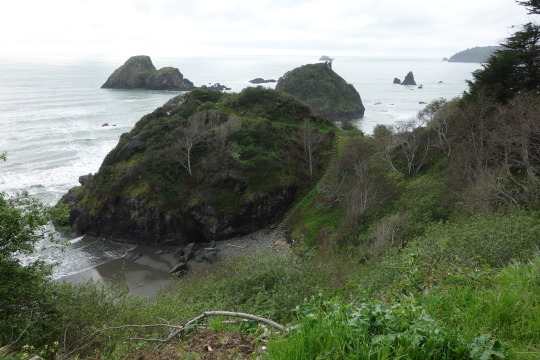
Day 1 (Crescent City to Clam Beach) -- 75mi/4.2k ft
https://www.strava.com/activities/948298792
When you roll out of bed and see your bike next to you, you know it’s going to be a good day. The storm had ended (for now). I returned the car at the world’s tiniest commercial airport after running a few last minute errands (patch kit and lighter are crucial). A polite and professional looking middle aged woman in a knee high skirt helped check the car back in. As I went to check the mileage a man with a mangled undercarriage came driving back up with a dumbfounded expression -- the cowling of the car was dragging on the ground, making an infernal noise. The rental car woman casually walked back in to grab a pair of tin snips. When she returned, she squatted down and removed the offending piece, then informed the man that he was all set. What service!
From there, I was free, off on my two wheels, fully supported. The day was sunny, dry, and a bit windy, but still gorgeous. The road felt solid under my self-propelled vehicle; my legs marginally ready for the physical challenges ahead. The cliffs along the ocean fell away like they had been cleaved by the great Paul Bunyan himself. The ocean would be my comfort, my well of motivation for the next several hundred miles.
The miles of coastline stretched endlessly in front of me. I rolled along undulating roads that led to tiny coastal towns; nearly forgotten, yet timeless. The forest stood sentry over the towns, over the coast, and over me.
Several hours of headwinds and roughly 40 miles in, I stopped in Klamath Falls to admire the 40 ft tall Paul Bunyan and Babe the Big Blue Ox. It dwarfed me and my bike. My hunger had built, so I indulged in a plate full of chili fries and a sandwich at a nearby cafe in False Klamath; got to love being a cyclist, you can eat anything and it’s all considered fuel for the next ride. I had been cruising at 13 MPH, slow and steady, and this would be pretty much the fixed speed that I’d be moving at most of the trip.
After lunch, there were a few decent climbs: one up to Prairie Creek Redwoods and another out towards the stunning Patricks Point. A few lagoons loomed in the distance, they distracted me well enough for about 10 miles as I rounded my way to the campground.
I landed in Clam Beach State Campground after deciding to press on passed Patricks Point (my original stopping point for the day). The tent was a small project, as it was my first time pitching this new 1p tent, which proved to be a trivial task. The hunger was driving me to skip the backpacking meal and opt for some pizza at a local joint in McKinleyville. The kids working did not care if I brown-bagged it while eating a few slices in their store -- likely not their first dirtbag cyclist. Four slices and a 22oz of IPA prepped me pretty well for passing out. There was a slow ambling pedal along the airport road that led me back to camp. A few small planes landed during the sunset and I soaked in how light everything felt, nothing was tugging at me or compelling me to do or be anywhere, I was exactly where I needed to be.


Day 2 - Clam Beach Campground to A.W. Way County Park (Mattole Road) -- 75mi/5k ft
https://www.strava.com/activities/949287569 https://www.strava.com/activities/950851373
The first light of the morning woke me and I felt rested. I wanted to get an early start on the morning since rain was in the forecast, but not until afternoon. I planned on covering a fair amount of ground before the rain came (hah). As I packed up, my camp neighbors warmly offered me a cup of coffee, they lived locally and told me they were getting ready for work -- made me reminisce about camping up at Hawk Camp back home during a work night. The kindness of strangers would be a recurring theme during my trip.
Breakfast was eaten on the bike; the convenience of a breakfast burrito and a chocolate milk on the road. It conjures up an image of a train engineer shoveling coal into his engine to keep it chugging along. The morning was beautiful, I mostly pedaled by coastal farmlands and a smattering of small towns. The headwinds were ever-present, but I felt strong nonetheless. I caught up to another cyclist in Eureka who looked like he was out bikepacking with his loaded panniers, I excitedly asked him where he was off to. He was commuting to work and wasn’t on much of a journey. I wouldn’t encounter another cyclist until my last days of riding.
The farm roads gracefully lead me to Ferndale (my halfway point for the day) where I loaded up on provisions. While visiting a grocery store, I absentmindedly left my sunglasses on a rack and left for a pastry and coffee (I retrieved them). A local who had been in the store had noticed me down the street and flatly observed “you didn’t make it very far” when he saw me in front of the bakery. I’ll call that small town humor.
The climb out of Ferndale was absolutely brutal. It felt like hitting a vertical wall and only the powers of levitation would be able to lift me up the ridgeline that I was attempting. I was desperate to move quickly, but humbled by the aggressive grade and the howling winds at the top of the climb. The threat of rain was no longer merely a threat, I donned my rain gear quickly and prayed that I’d stay dry and cool enough to finish out the next 30 miles. From Ferndale, I covered about 4.2k ft in 35 miles. Brutal with packs, brutal without them.
Needle like rain stung my face for over an hour, my amusement during this section quickly changed. A sketchy winding descent led into Capetown, where I lost one of my water bottles and I narrowly missed being crushed under a dump truck’s wheels. The trucker that was just a tad too comfortable with the roads and cyclists on them.
Following the descent into a cove, a local in a green Tacoma stopped ahead of me and dangled a construction high-visibility vest out of his truck window and stated “dude, you need this!” His name was Oliver, and again, strangers with endless kindness had been looking out for me with safety and hydration (Oliver gave me a water bottle to replace mine, it was even alkaline, for sensitive stomachs). My flickering flame was ablaze for the adventurous path again.
A few miles ahead there was the town of Petrolia with a little gem of a bar called White Rose. I saddled up at the bar to wait out the storm. A beer would revive my sense of humor and the locals were entertained by my very presence. Who bikepacks in the rain, they asked? A few randos contributed to a hot shower fund in their own amusement since AW Way Campground had a coin-op hot shower. The kindness of strangers also contributed another gift from Humboldt county too, a special little doobie hand rolled under the bar. Despite the fact that it had only been two days of pedaling, I felt the beginnings of loneliness assuaged by strangers. I was striving to stay open to any experience along this road.
The campsite was a few flat miles from The Rose (as the locals referred to it), I even turned down several ride offers, told them that this was my journey to power. The campground boasted 30 soggy sites, they were all empty, so I had my choice. The hot shower was restorative, a bit of magic for a renewal that I would need for tomorrow.


Day 3 (AW Way Campground to Wright Beach 76mi/10.3k ft via Usal Road)
https://www.strava.com/activities/950851391 https://www.strava.com/activities/951928834
There’s always an odd sense of waking up in a campground without anyone else around; it’s a bit eerie, but also deeply peaceful. Rested, I packed up and hit the road, noticing a new lovely creaking noise my bottom bracket had developed due to all of the rain.
The plan was to take Mattole Road and connect to Usal road despite most people informing me that Usal road was still closed, but I felt that I didn’t have much of a choice since the reroute due to all the highway road closures would climb up and over Garberville and add an extra 70-80 miles (I had no idea how much climbing it would add). The folks from the White Rose had informed me that the Bryceland Market would be a good place to stop for food and road intel.
Still groggy with sleep encrusted eyes, I rounded a bend, and from the shoulder of the road a blur of black streaked ahead and veered into the center of the road and turned around to face me. It was a bull, of sizable proportions! He pawed at the ground as if to feign a charge. This frightened me, but I took comfort in the fact he didn’t have horns, nor did he have testicles (minor thing noted when he ran ahead of me), but I was leery of this 1500lb bulldozer and hoping he wasn’t too aggressive. I stopped about 50 yards away from him, facing him down like it was a standoff (it felt like a David and Goliath faceoff). I first yelled at him, then rang my bell, tossed small rocks in his direction to get him to move out of the road. He wasn’t budging. Then I thought to channel my inner cowboy spirit, and boldly rode towards him, yelling at the top of my lungs “GO ON, GEEEIIT!!”. This magically compelled him to turnaround and he trotted in the direction that I was rolling in. My inner childhood cowboy was giddy and terrified all at the same time. Such power I yielded. The bull veered off the side of the road before we got to a cattle catcher and I was free from my escort/keeper. I pedaled off to safety, and continued binging on serial killer podcasts, such a odd choice for a sojourn on desolate mountain roads.
Honeydew was a good restocking point where I pounded yogurt like it was water. They had a map of the area and informed me that Usal road was still closed, but I should check in with the BLM office in King’s Range. Just outside of Honeydew, there is a massive climb that aggressively stretches up to King Peak. It humbled me. I stopped several times to give my knees a break and to lube my chain. At one mini pitstop, a local named Grant stopped to check in on me, and I informed him that I was ok, and instead of speeding off to his day, he casually chatted with me for a few minutes. I inquired about Usal road, but he didn’t know much about its current state. The next several hours were a virtual elevator of careening ridgelines, towering forests, washed out roads, and serial killer podcasts.
Dropping into Thorn Junction, I crossed paths with Grant again, he was hauling a load in his truck, and chatted with me briefly and offered up an apple juice. I was thankful for the offer, and took him up on it. Each drop was refreshing, the kindness of strangers continued.
The BLM office was down the road another mile. There was one woman with a colleague there, they both heavily advised me not to take Usal, not that it was a fool's errand, but pretty close, saying that I needed a mountain bike or something beefier than my cross bike (on semi slick 32s). They weren’t exactly too far off, but I decided Usal was my best option, considering my current location and what I could physically tolerate (at this point I was 40 miles in and nearly 5k ft climbing).
There was a awkwardly situated cafe in a lumberyard called Caffe Dolce. Their pastries and sandwiches were exceptional. Both the fuel and the rest were a much needed respite. I was surprised at how busy the cafe was. There was a constant stream of people coming out to pick up a sandwich, I surmised that they were all potentially pickers at some of the farms in Humboldt county. I overheard an Aussie gal talk about going back to the farm.
Back on the bike, there was a smell of dank herbal piney resins wafting at me, I was definitely in Humboldt county. To punctuate that point, I was nearly at Usal road, pedaling along fern laden roadways, when a women walking along the road was most certainly on a different plane than I was. She stated everything is beautiful and asked me for a hug, which I complied and listened to her delve into hyper connected beauty and how we’re all one. I was grasping for an understanding of what all she was conveying to me. I pointed her the way that she should continue walking, and hoped that somebody would return her to wherever she had come from. Bizarre.
Usal’s beginning was a formidable muddy clay-like road, deeply rutted and pocked. The mouth of the whale that would swallow me up and eventually spit me out some ~30 miles and 4k ft climbing later onto highway 1. I ignored the closed gate and passed by. There were rollers that climbed and descended into expansive groves, with each descent typically requiring me to dodge pond-like flooded sections of the road. At least 3 cars were abandoned, a Honda Civic had no chance, the two trucks, despite having 4 wheel drive, succumbed to the relentless muck.
I pushed on. I was grinding away at 6-7MPH for the next 6 hours. I had to dig deep and find humor in the pain and to not let all the beauty wane. My nerves were starting to wear and my body was feeling tired of endlessly riding the brakes and carefully choosing my line, which was even harder with a load. The risk was high since both ends of Usal road were closed and I didn’t have any phone reception. A single mechanical issue could ruin the trip, a fall was a different story… actually, I laid the bike down on one slick descent and took a tumble. I was incredibly thankful -- no mechanicals or injuries.
After a few more hours of rocking out (fittingly enough to If These Trees Could Talk) and noting the descending sun, worry began to set in. I wondered if I’d ever get through this seemingly endless road. My strength was waning, but mentally, I was committed to getting through this. After rounding one of the innumerable bends, Usal beach revealed all its glory, just in time for the sunset. This helped to steady my nerves, as I knew there should be a camp nearby. Indeed there was a camp at Usal Beach, but I was pumped and ready to bid this road farewell, so I cranked on into the night. I climbed another 2k feet and rode another 16 miles in the dark. Thankfully, I had my headlight that was charged, but unfortunately, my taillight died on me. There were just a few cars that passed me (it was 9pm on a Thur night with a highway closed just North of me, hence why I decided to commit to Usal route).
Haggard and nearly broken, I arrived at Westport-Union Campground. I had been on my bike for nearly 15 hours that day. The campsite was on a bluff, the chill winds were refreshing, and helped to cool my nerves. What a day.
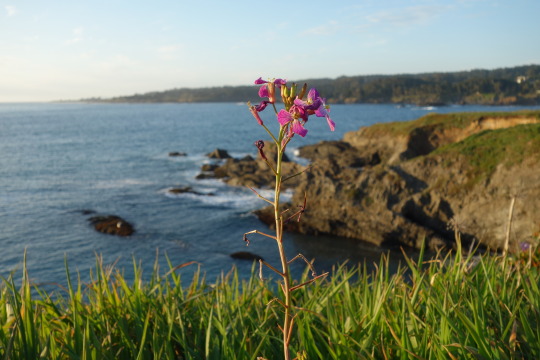
Day 4 Westport-Union Landing to Russian Gulch (28mi/1.5k ft)
https://www.strava.com/activities/951928593 https://www.strava.com/activities/953575322
There’s a smile that creeps across your face knowing that you accomplished something that most people wouldn’t dare to attempt, it’s not like I rode a 24 hour endurance race, but it still something to take some level of pride in the accomplishment. As the sun crept up and the ocean sang it’s morning chorus, I couldn’t help but reflect on the tough day; my body was spent. Thankfully, there was a short road to a recovery day, as I was meeting the rest of the Coyote Bomb Squad in Russian Gulch for two chill nights of camping.
I pedaled through Westport, a quirky little coastal town (more like a hamlet), with a tiny cemetery situated on the bluffs and some funky whale mosaic fountain. I savored my breakfast sandwich from a small market run by sweet earthy ladies and then slowly rolled towards Fort Bragg. Coming into Fort Bragg, I stopped in the local coffee shop before hitting the local bike shop, Fort Bragg Cyclery, and chatted with the owner, Mark. Later, I picked up some Teknu since I had managed to hit some poison oak on Usal road. After scarfing on the best pizza in town, Piaci Pizza, and sharing a surprise beer with Mark (bike shop owner), I cruised off to the campsite to meet up with my friends.
Several days on the road riding solo can be a great time for self-reflection and really stoke the fires of your inner hobo, but there are those moments when you’re inundated with gratitude for good friends and their adventurous spirits. I was happy I didn’t have to ride any further and more importantly, elated to be around the warmth of friends and the warmth of my first campfire of the trip. The sunset on the bluffs was of epic proportions.
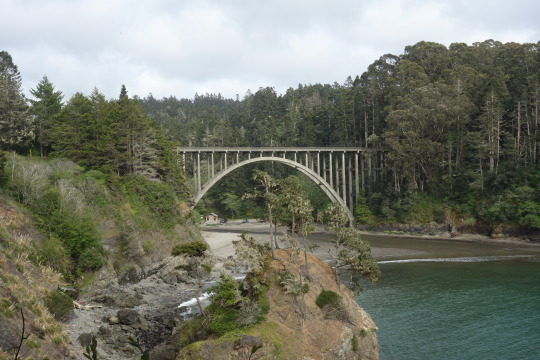
Day 5 Russian Gulch Exploring, Canoeing, and Hardcore Chilling
Nothing is sweeter than sleeping in and waking up to the smell of hot buttermilk blueberry pancakes cooked on cast iron. Resting, chowing, and some mellow canoeing was on the agenda for the day. We gawked at the ultra-marathoners running through our camp; a funky route, and oddly enough, the canoeing location was the finish line.
Catch a Canoe and Bicycle Too was a quirky shop filled with collectors bikes suspended in the rafters, a series of beautifully crafted “toy” rockets, which looked like they could deliver at least a marmot to outer space, all run and owned by an idiosyncratic shopkeeper. He seemed half-wizard, half rocket scientist, and likely was the most intriguing person that I had encountered while on the trip. His knowledge of photography and rockets was astounding, and he ran a bike shop and a canoe rental business too. And these weren’t just any canoes, these were real works of functional art, just like one would imagine with a beautifully crafted bike, these were easily the most beautiful water-worthy canoes I had ever seen, not to mention the fastest; replete with outriggers for stability. I can’t recommend this experience enough; anyone can manage to enjoy a languid paddle up a gentle river in one of these. On the river, there’s a calm that’s induced that coaxes one to slow down to drink in all the fresh air and sights. Even a handful of seals with pups laid around without a care in the world. A few hours worth of this and it’s like hitting reset on your body. Just mellow; nowhere to be, but right where you are.
The remainder of the day was just chilling with friends, scarfing yet another burrito, and roaming around the bluffs followed by an epic paella cooked by the birthday boy himself, Youngblade.
Day 6 Russian Gulch to Bodega Bay (102mi/6.5k ft)
https://www.strava.com/activities/955648904
These are the types of days that most riders dream about: a good deal of rest, a pancake breakfast, and an epic tailwind that would leave most vikings envious. Despite the fact that the option to hop in a car was there, I opted to pedal the remaining miles back home in 2 days. This might have been one of my favorite days of riding. The hills were fast rolling, each corner plunged down toward the ocean and climbed back up along a coastal bluff. The farmlands added to the serene and bucolic views that elicited a smile. Such a beautiful coastline, such a simple life that calls you to standstill, reflect on a slower pace of nature and the simplicity of it.
Each descent propelled me closer to home and I began to squirm a little thinking about joining the fray again. I pushed on.
Point Arena is a small town that boasts having one of the oldest lighthouses on the coast. It’s a cute and quaint little pitstop close enough for a number of motorcycle riders to reach it from the Bay. A weird sight: hippy/coastal/biker community. California is filled with contradictory juxtapositions, but that’s one of the reasons I love this state. After a solid lunch, I caught up to a crew of riders bikepacking, the only legit riders I had seen! The trio were Canadians heading down from, well, Canada and going down to LA. I was impressed with the amount of beer they were loaded with and sad to turn them down to join them. I had hoped to finally exchange some road stories with fellow riders. There was a brief stop at Salt Point with them, but I felt great from that luscious tailwind, even after 75 miles, and decided to push on to Bodega Bay, about 30 miles down the road.
I rolled into Bodega Bay around 6pm and treated myself to a quality glass of wine and a massive fillet of halibut. So perfect, so nourishing. The campsite at the dunes was a windy one, and made it challenging to sleep despite wearing earplugs. No wonder it’s a favorite spot of windsurfers. Some peculiar dreams crept in that night. Maybe the corporate lifestyle or the dread of the routine that was right around the corner.
Day 7 (Bodega Bay to Larkspur to SF 65mi/3k ft)
https://www.strava.com/activities/956749405
The morning dew hung tightly to everything in sight, it limited my vision, and would eventually morph into a full rain. Undeterred, I knew a hot bath and a cold beer was at the end of my road, but first, I needed a solid breakfast. Estero Cafe delivered. Seated just outside of Marshall, it’s a quaint little organic farm to table type of place, but felt more like a cafe that you might encounter in anytown USA with the local sheriff stopping in and a few regulars just picking up their morning joe. The mist had built up to a sprinkle after I finished my last bite, so it would be a drizzly ride home. Another 60 miles of meandering through dairy farmlands and verdant hills. A host of classic porsches from the 50s zipped along the same roads, they respected me and I certainly marveled at their classic contours.
Fairfax is always a favorite destination of mine, as many bikers can attest. There is a shared love for bikes in this upper-crust hippy town (seemingly contradictory). Gestalt was on my mind, after collecting rain in my shoes for the last 50 miles, I was ready for a beer and a sausage. Both were savored. I felt lonely and wanted to share my journey with someone like I had done the previous year after a longer tour, but nobody extended me the pleasantries. A tired and weariness settled in from the week of riding, yet there was a lingering satisfaction from knowing what I had accomplished.
I opted to take the ferry back to save a few miles and to soak up the bay and the bridge from a different perspective. The quiet Monday afternoon in the city made it feel like a distant stranger, as the streets were quiet. The city towered over the mouse in a familiar concrete cornfield. It felt good to be home; an appropriate way to close out one chapter and start a new one. The cycle continues, as does the adventure, it always will.
1 note
·
View note
Text
A freeway employee was killed along with his automobile on the North Shore of Tahoe
The California Freeway Patrol mentioned a automobile fatally hit a highway employee Monday evening on the north shore of Lake Tahoe, and the driving force was suspected of being drunk. The accident occurred round 10:44 p.m. on North Lake Boulevard (Freeway 28) on Sahara Drive, within the Baton Seashore space of Carnelian Bay. Based on the CHP, a person from Tahoma was heading west on the freeway in a Subaru Forester. Highway development was underway on the intersection with Sahara and there have been one-way site visitors controls, with a employee directing westbound automobiles to the other lane. The Subaru driver did not appear to note the lane closing till it was too late. The automobile collided with the employee after which collided with a dump truck and an excavator. The employee was declared lifeless on the scene of the accident. The driving force was arrested on suspicion of driving inebriated or medication and was taken to the Nevada County Sheriff’s Station in Truckee. Exterior the development zone, the velocity restrict on the stretch of the two-lane freeway is 45 miles per hour. North Lake Boulevard remained closed at this location till about 10:30 a.m. Tuesday. It reopened with one-way site visitors controls for the constructing. Originally published at San Jose News HQ
0 notes